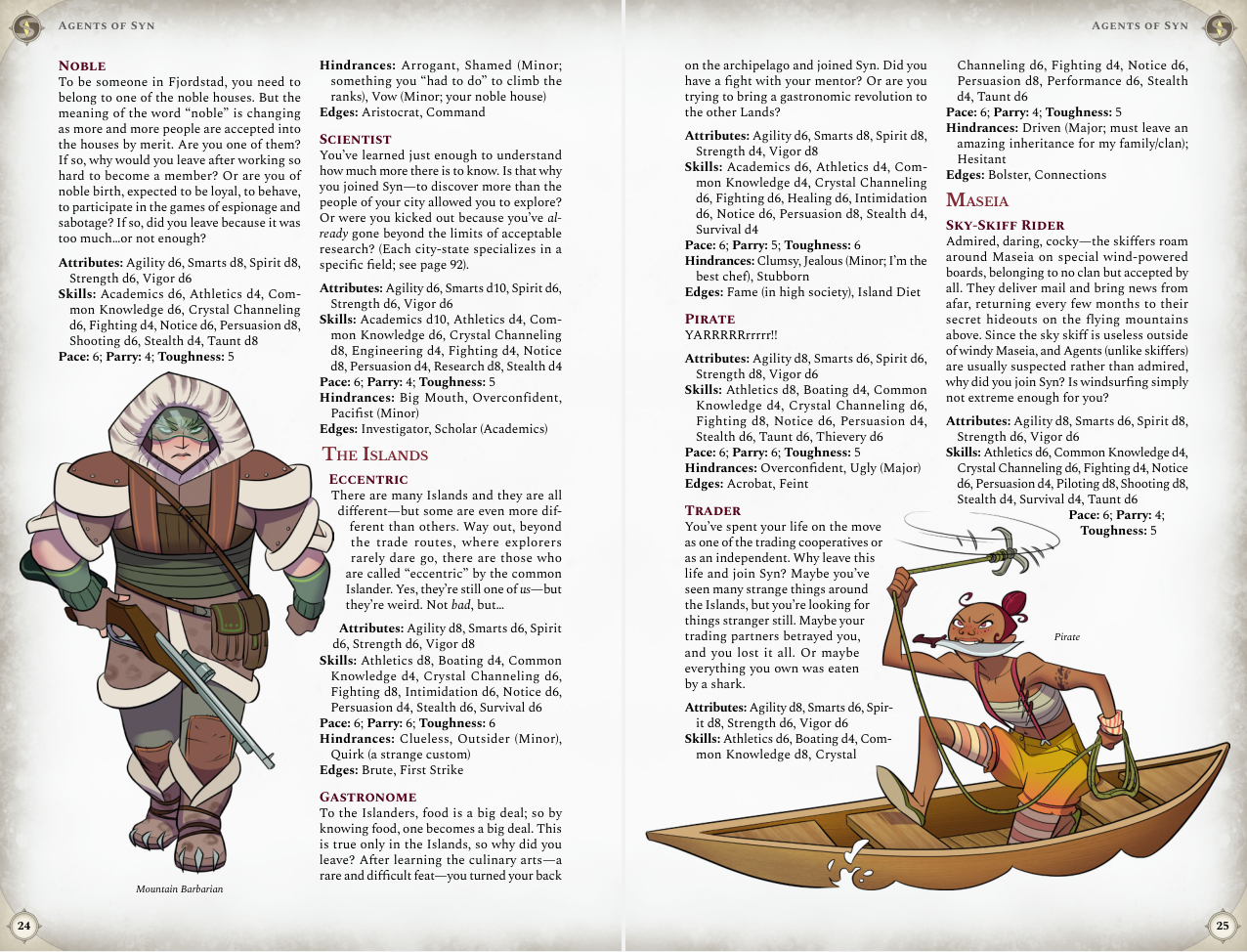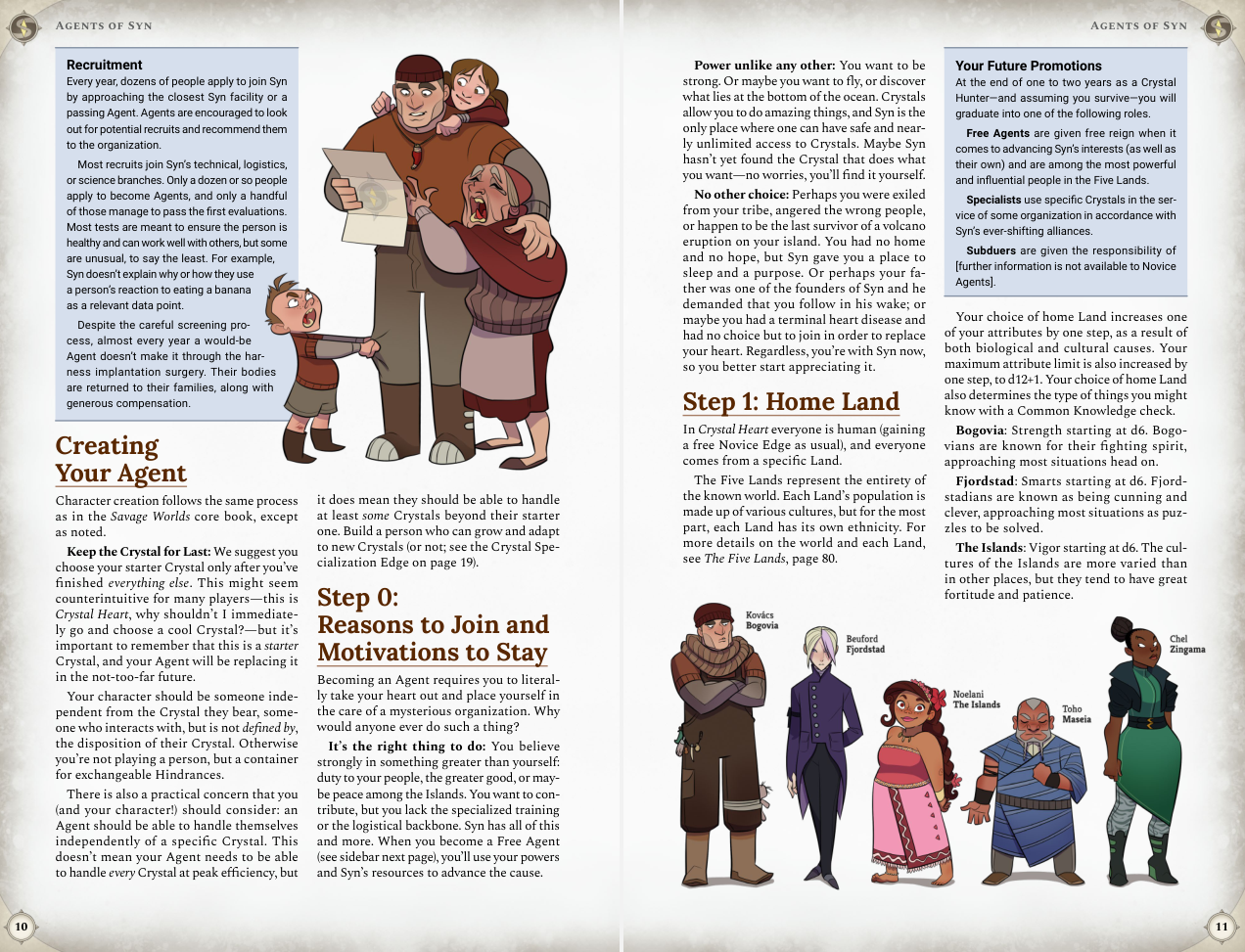Signature and motivation to focus your character
This weekend I ran the first character creation session, and I've got thoughts.
The main issue to tackle is "where to begin visualising". In D&D and Pathfinder you usually start imagine your character with either their ancestry or class, which is a solid basis. Vivid is an open system, the player is asked to create their character by choosing from lots of skills, and that can feel like "where do I even begin", so the player should be provided with some skeleton, something to start with.
In Savage Worlds they don't do that. Instead, they provide examples to inspire and show what's possible. They provide archetypes, a dozen or so pre-built PC stats to show you the variety of people you can play. Here's an example from Crystal Heart, where we did the same:

Inspired by this I created several archetypes for Vivid, and used them as the pregens for convention games. However, I find this approach to be less than ideal, and I would rather provide the player with an actual skeleton to put clay on, rather than mimicking other clay figurines, if you get my analogy.
I went back to the source inspiration: TV action-adventure animation series. What do the protagonists there usually have, what's the basis for their character? The answer is pretty obvious, actually: they have a motivation and a cool power or tool. So maybe that's where I should begin.
Signature
When I talked about magical items, I mentioned how players can choose to keep one signature, an item that is bonded with them and will not turn to dust (Or maybe ash? Maybe I should call it ash. [And like Ash, the PCs do indeed try to catch all of them magic items]). I came up with signature when I was thinking about the type of player who enjoys having their cool item and would like to safely explore various ways of using it - but I soon realised that's actually what most TV protagonists do: use the same tool in different ways. So maybe the signature isn't something you get, it's something you start with - and build yourself around it.
Motivation
Motivations are core to my understanding of PCs in roleplaying games. It's the reason why a PC engages in this adventure with these people. The more specific the premise of the campaign, the easier it is to identify the possible motivations for it. For example, see step zero of character creation in Crystal Heart, a game with a very specific premise: You belong to an organization and you seek Crystals.

Vivid also features something like an "adventuring organization", which is similar to Syn in that it provides a coherent core for the group to form around. My current playtesting environment, however, is the Dusk Barrens, a part of the world that is designed to be a West Marches-like setting (I'm trying to see if Vivid can support this kind of play). I created the Barrens for 5e several years ago, as an experiment I never got to run, and now I'm converting it all to Vivid. Here you can see the player portal I designed.
Thankfully, I already did some motivation mapping for DB (mid-page here), so I just copied it to the Vivid version. EASY
So what does the skeleton look like?
It starts with ancestry. I have several, all of which I think are pretty cool, but we'll talk about them some other time. They give you the basic "where I am in the world". If you want to play a person with no home, for example, you would probably choose a goblin. And it's the other way around: If you choose a goblin, maybe just because you like their aesthetic, your skeleton begins to form - it's a person with no home. Each ancestry recommends a specific skill development, to already make you think about skills.
Then we go to signature. You choose (or draw on a random table) a core magical items that serves as your first signature. If you take boots of silent sneaking, well, you're "a rogue"; if you take a bow of splintering arrows, you're "an archer". Signature items aren't as powerful as skills - if you don't choose Sneak, you're not a great "rogue" - but they provide a starting point, to guide you later when you do choose skills.
Finally you have motivation, a list of several general ideas. Technically you're not limited to them, but you really should choose one of them, since they make sure your PC belongs in this game (Thankfully, when the rules present the player a table, they're going to choose from that table). Each motivation has a list of several recommended skill developments; if you're looking to hunt the most glorious beast, you should have Beasts. But you don't have to. Maybe the character is rubbish at hunting, and you're already imagining how one they she'll have to realise her dream can't come true, and think on what comes next.
Finally you go on to choose skills, only now it feels like you already know who you are playing, and choosing skills is pretty straightforward.
All in all, it took about 45 minutes, which is excellent considering no player has done this before (nor have I), and no one yet know the system very well. We ended up with three cool characters, only one of which can be described as a "class" (Aviv made a straightforward dwarf "fighter", mechanically, who had an incredible signature and motivation), but all of which are legitimate Dusk Barrens explorers.
Hope to keep exploring these lands further! We'll see.
Vivid
Draw, describe, decide - action!
| Status | In development |
| Category | Physical game |
| Author | Eran Aviram |
| Tags | Fantasy, roleplay, Tabletop, Tabletop role-playing game |
More posts
- October development summaryOct 19, 2024
- Many small improvements, bundled upFeb 12, 2024
- September playtest summarySep 25, 2023
- Three and a half humans, goblinorcs and wyrmsAug 07, 2023
- Magic items turn to dust, and that's a good thingJul 13, 2023
- June playtest summaryJun 26, 2023
- Emulating the fight of Balin's TombJun 02, 2023
- Colour-coded challenge ranksMay 22, 2023
Leave a comment
Log in with itch.io to leave a comment.